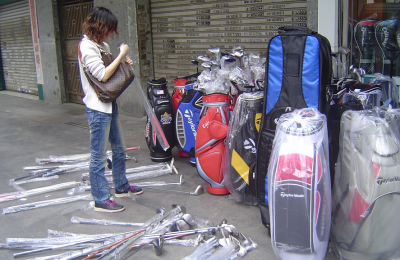It’s not easy to tell when a club is counterfeit, so a golf manufacturers group is focusing on education and enforcement in an effort to clean up the marketplace

By AL PETERSEN
You get what you pay for, and if you paid $375 for a full set of new Callaway or Cleveland clubs, they’re likely counterfeit.
You also unwittingly (or not) were part of an economic trickle-down scenario that affects a number of people. It’s bad for manufacturers, who take a hit financially and to their reputation. It’s bad for golfers, who spent money on what they thought was a legitimate product. And it’s bad for the local economy, because reputable equipment dealers big and small are losing out on money from sales that are going to bogus sellers.
“These clubs aren’t just knockoffs, they’re fakes,” said Jason Rocker, spokesman for the Golf Manufacturers Anti-Counterfeit Working Group. “Counterfeit golf is a multimillion-dollar business. The problem is significant.”
It’s been significant for a number of years, and the group was formed in 2004 to counteract the counterfeiters, who produce an estimated 2 million clubs each year. The consortium of manufacturers, which includes Callaway, TaylorMade, Cleveland, Acushnet and Ping, has made strides in that time, but 2011 was its best year with more than 95,000 counterfeit products confiscated. That’s nearly four times the amount seized in the previous year, and the increase can be traced to more worldwide law enforcement cooperation and efforts to educate the public about illegal goods.
Rocker warns golfers to think twice about buying golf-related items from websites that ship from China because about 90 percent of counterfeit equipment and accessories are made in that country. Most of the counterfeiters sell their bogus wares online, so the only way to ensure you’re getting the real deal is to buy directly from the manufacturer or a retailer you know is above board. The best way to do that, he said, is to check the list of authorized retailers at the bottom of each manufacturer’s website.
“Buy from an authorized retailer and you know you’re buying a legitimate product,” Rocker said. “Otherwise all bets are off and you’re rolling the dice.”
The Golf Group capped 2011 with two December raids in Chinese cities that led to the confiscation of more than 7,000 fake clubs and more than 8,000 combined counterfeit golf products. Rocker said the group can’t put a dollar figure on the goods because no one is sure what materials are being used.
“The challenge with these counterfeiters is that there’s no quality control, so the damage can be anything from a loss of accuracy and distance to safety issues where a shaft can shatter at the ends and heads can fly off mid-swing,” Rocker said. “So the reality is you just don’t know what you’re getting on a number of levels.”
Since it’s difficult for the average golfer to spot a fake because logos look real and the clubs feel right, Rocker said the group is concentrating on education as well as enforcement moving forward. The group launched a website (keepgolfreal.com) last July to help in that regard and has received thousands of hits and visitors from around the world. Among other things, the site answers questions about fake clubs and gives updates on enforcement victories.
“Our success goes beyond the numbers,” said Michael Rider, senior vice president and general counsel for Callaway. “We stopped the production of a large number of fake clubs, but we also successfully launched an educational campaign with our Golf Group website. Through that, we’ve given thousands of people tips on how to avoid counterfeit purchases. That is as great of an accomplishment as any of the raids we conducted.”
While focusing on monetary figures and education are keys to the group’s success, Rocker said those issues are only part of the reason why ridding the marketplace of counterfeit clubs is so important.
“It comes down to protecting the brand they worked so hard to build,” he said about the manufacturers. “But even more than that, it comes down to protecting the integrity of the game. Because ultimately these aren’t just golf manufacturers, they’re stewards of the game.”
And even though golf is seen as a solo sport, the issue will take teamwork to succeed, Rocker said.
“The reality is, as long as there are people who are willing to buy counterfeit clubs, there are going to be counterfeiters who are willing to make them,” he said. “It’s a big problem that everyone involved in golf or who loves the game should want to see eliminated.”

